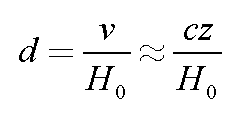Astronomy 162: Introduction to Stars, Galaxies, and Cosmology
Todd Thompson
Department of Astronomy
The Ohio State University
Lecture 34: Cosmic Distance Ladder
- Measuring the Hubble Parameter, H0
- Distance Methods:
- Trigonometric Parallaxes
- Spectroscopic Parallaxes
- Cepheid Period-Luminosity Relation
- Galaxy Standard Candles
- Galaxy Luminosities
- Redshift Distances
The Distance Problem (again!)
Cepheid P-L relation is good but limited:
- Limited to ~30-40 Mpc (Hubble Space Telescope)
- Very laborious to use (100's of HST orbits)
- Only works in Spiral or Irregular galaxies
- Only practical out to the Virgo Cluster
This is only next-door in cosmic terms, so we need to seek other methods
to estimate very large cosmic distances.
Hubble's Law & its Discontents
Ideally, we could just use the Hubble Law:

(Graphic by R. Pogge)
At least nearby, all you need to measure is the cosmological redshift, z,
in order to get the distance.
The problem is, what is H0?
Steps to the Hubble Parameter
No single distance method is universal.
Must work towards large distances from nearby.
Bootstrap Process:
- Build up from near to far.
- Each step calibrates the next step.
- Errors made in early steps affects the accuracy
of all following steps.
Step 1: The Astronomical Unit
1 AU = Mean Earth-Sun Distance
Method: Geometric Triangulation
- Radar bounced off inner planets.
- Orbits of planets give the geometry.
- Works throughout the Solar System
Permits measurement of:
- Trigonometric Parallaxes.
Step 2: Trigonometric Parallaxes
Calibrated by the AU (size of Earth's orbit).
Method: Measure stellar parallax angles
- Use Earth as the baseline.
- Ground-based: works out to ~100 pc
- Space-based: works out to 500 - 1000 pc (Hipparcos)
Permits measurements of:
- Luminosities of nearby stars
- Distances to nearby star clusters
Step 3: Spectroscopic Parallaxes
Calibrated by Trigonometric Parallaxes.
Method:
- Relate spectral type to luminosity in calibrated H-R Diagrams.
- Works OK for individual stars.
- Works best for clusters of stars
Permits measurements of:
- Distances to star clusters out to ~50-100 kpc
This is enough to reach out to the Large Magellanic Cloud (LMC).
Step 4: Cepheids
Calibrated by cluster H-R diagrams.
Method:
- Cepheids: supergiants in young clusters
- Calibrate the Period-Luminosity Relation in the LMC.
Cepheids give distances to:
- Nearby spiral galaxies out to about 30-40 Mpc.
Only works for Spirals because you need young (Population I) star
clusters for Cepheids, and Ellipticals have only old Population II stars
and no young stars.
Step 5: Galaxy Standard Candles
Look for new, very bright standard candles that will be
found in both Spiral and Elliptical galaxies
- Type Ia Supernova explosions
- Planetary Nebula luminosity distribution
- Globular Cluster luminosity distribution
Calibrated by:
- Cepheid Period-Luminosity distances to spirals
- Nearby similar objects (from other steps)
Step 5 (cont'd): The Bottom Line
Variety of techniques get used:
- Mix and match to seek consistent results.
- All rely on previous steps, especially Step 4.
- Argue endlessly about the details.
Bottom Line:
- Work out 50-200 Mpc, depending on the method.
- Gives distances to Virgo Cluster galaxies (Spirals and Ellipticals)
- Gives a local estimate of H0
Step 6: Galaxy Luminosities
Calibrated by the distance to the Virgo Cluster
Method:
- Assume distant galaxies are like nearby ones.
- Find correlations between the luminosity &
distance-independent properties of the galaxies.
- Compute a luminosity distance using entire galaxy.
Seek a refined estimate of H0 out to greater distances that
gets you beyond the regime where the random (aka "peculiar") velocities
of galaxies due to their orbits around each other or within groups are
important.
Step 6 (cont'd): Specific Techniques
Tully-Fisher Relation for Spirals:
- Galaxy Luminosity - Rotation Speed relation
- Rotation speed from 21-cm radio emission
(distance independent)
Fundamental Plane Relation for Ellipticals:
- Galaxy Luminosity - Line Width - Size relation
- Measure absorption-line widths from spectra (distance independent)
Step 7: Redshift Distances
Calibrated against all previous steps.
Method:
- Measure the redshift of a galaxy with spectra.
- Use the estimate of the Hubble Parameter.
- Assume pure "Hubble Expansion" or attempt to correct
for random galaxy motions statistically.
Allows us to probe the Universe on the largest scales observable.
Current Status
Current critical areas:
- The most critical is the distance to the LMC, which calibrates
the extragalactic Cepheids P-L relation.
- Refinement of other standard candles, especially Type Ia supernovae
which could work out to 1000 Mpc.
- Statistical assessment of the random motions of galaxies.
Best Estimate: H0 = 70 +/- 7 km/sec/Mpc
- Many methods give consistent answers
Why do we care?
Measuring accurate cosmic distances is essential for answering these
questions:
What is the Hubble Parameter (H0)?
- Current expansion rate of the Universe.
- Leads to an estimate of the Age of the Universe.
What is the expansion history of the Universe?
- Would tell us the ultimate fate of the Universe.
Updated/modified January 2011 by Todd Thompson
Copyright Richard W. Pogge,
All Rights Reserved.

